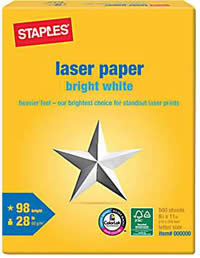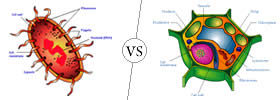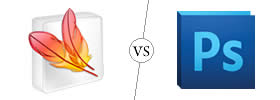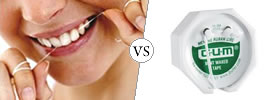Difference between Inkjet and Laser Paper
Key Difference: In Inkjet printers, the ink is blown into a heated vapor, which is then sprayed onto the paper. Hence, inkjet requires paper that absorb fast and keeps the ink from running or bleed. In comparison to this, laser printer paper is highly absorbent as the toner is burned on the paper using heat rollers. The rollers melt the toner, which is then absorbed quickly by the paper and then cooled. This keeps the toner from smudging or bleeding to the sides.
 Inkjet and laser printers are two types of printers that are available on the market. The two printers are highly different from each other and use different processes to print a document. Because of these different processes, the printer also requires different kinds of paper. Each printer can run the regular printer, but for special objects, the printers require different papers. These papers are used for purposes such as photos, presentations or producing high-quality text and images.
Inkjet and laser printers are two types of printers that are available on the market. The two printers are highly different from each other and use different processes to print a document. Because of these different processes, the printer also requires different kinds of paper. Each printer can run the regular printer, but for special objects, the printers require different papers. These papers are used for purposes such as photos, presentations or producing high-quality text and images.
In order to understand why they require different papers, it is first important to understand how each printing process works. Inkjet is a type of printer that produces images by propelling droplets of ink onto the paper. It has a series of microscopic nozzles that spray a stream of ink directly onto the paper. The nozzles either have a high pressure pump or tiny heating elements behind them that helps deposit ink on the paper. There are two main technologies that are used in an inkjet printer: continuous (CIJ) and Drop-on-demand (DOD). In continuous technology, a high-pressure pump direct liquid ink from the cartridge through a gunbody and a microscopic nozzle, creating a continuous stream of ink droplets that are deposited on the paper. Extra unwanted ink is dropped into a gutter, which is recycled when the printer is active again. Drop-On-Demand is divided into thermal DOD and piezoelectric DOD. The thermal DOD uses a heating element to heat the ink in a chamber, which cools when applied to the paper. The piezoelectric DOD uses a piezoelectric material behind each nozzle instead of a heating element. In DOD, the printer cartridges fires ink only at special points on the surface that is required for creating an image.
 Laser printer is a type of printer that produces high quality text and graphics by passing a laser beam on plain paper. The machine uses the data sent from the computer to create a raster line or scan line. The Raster Image Processing (RIS), typically built into the printer, creates a bitmap of the final image in the raster memory. After this, an electrostatic charge is applied to the photosensitive drum. The system also applies AC bias to the roller to remove any previous charges and a DC bias on the drum surface to ensure a uniform negative potential. A laser is then fired on the electro statically charged light-sensitive drum. The drum then attracts the toner in the places the charge is still present. The drum then becomes hot and fuses the toner to the paper, which then produces the image.
Laser printer is a type of printer that produces high quality text and graphics by passing a laser beam on plain paper. The machine uses the data sent from the computer to create a raster line or scan line. The Raster Image Processing (RIS), typically built into the printer, creates a bitmap of the final image in the raster memory. After this, an electrostatic charge is applied to the photosensitive drum. The system also applies AC bias to the roller to remove any previous charges and a DC bias on the drum surface to ensure a uniform negative potential. A laser is then fired on the electro statically charged light-sensitive drum. The drum then attracts the toner in the places the charge is still present. The drum then becomes hot and fuses the toner to the paper, which then produces the image.
These processes demand that each printer use a different type of paper best suited to the process run by the printer. In Inkjet printers, the ink is blown into a heated vapor, which is then sprayed onto the paper. Hence, inkjet requires paper that absorb fast and keeps the ink from running or bleed. The paper also cannot be too absorbent as the ink would also be absorbed by the surroundings of where the ink was originally placed. Inkjet papers are also less bright and glossy as the ink would not stick on the glossy paper. Inkjet paper is thicker compared the standard copy, but thinner compared to laser paper. If the paper is too thick, it keeps the ink from getting absorbed into the paper. Inkjet papers are designed specifically keeping the inkjet process in mind.
In comparison to this, laser printer paper is highly absorbent as the toner is burned on the paper using heat rollers. The rollers melt the toner, which is then absorbed quickly by the paper and then cooled. This keeps the toner from smudging or bleeding to the sides. Laser papers are high in gloss and brightness as it helps the toner get burned onto the image, producing higher resolution images or text. Laser paper is usually thick to allow it to tolerate the heat from the rollers. Laser papers are created thick, high gloss and heat tolerant, keeping in mind that the toner has be burned onto the paper.
Images Courtesy: staples.com









Add new comment